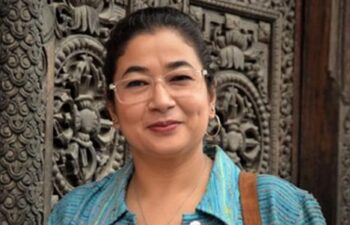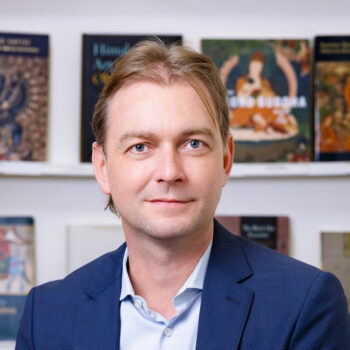
Courtyard view of Itumbaha, photo by Pranab Joshi, courtesy of Itumbaha

Courtyard view of Itumbaha, photo by Pranab Joshi, courtesy of Itumbaha
Rubin Museum Executive Director Jorrit Britschgi interviews Swosti Rajbhandari Kayastha, a scholar of Nepalese art and culture who serves as a lecturer of museum studies at Lumbini Buddhist University, about her role in the development of the Itumbaha Museum.
This interview was conducted on July 17, 2023.
Swosti Rajbhandari Kayastha: While I was doing provenance research, the Keshchandra Mahavihara Conservation Society, Itumbaha expressed their long-term desire to open a museum. I felt very happy that they realized the value of a museum. They asked me whether I could help them support the creation of a museum. I felt the pride that they take in their cultural heritage. Being one of the few academically trained museologists in Nepal, I felt it was my calling. I felt very passionate about their passion.
You had mentioned to me that the Rubin is happy to support the Keshchandra Mahavihara Conservation Society, Itumbaha in whatever ways are possible. I asked Itumbaha people if they had the budget, and they said they didn’t. So what they wished for and what you wanted—it just fell into each other. I felt very happy to be that connecting point.
I do see a growing interest in it. There are lots of gaps in between the growing interest and the execution of that interest. For example, take the Lumbini Buddhist University’s museum studies program that started in 2016. There were not many students in the beginning. The first batch was just four or five students. Then slowly, we built up. During the COVID time, we had 11 students, but many of them dropped out because of the pandemic. Even from the university, there was not much support to run the program. Without advertisement and marketing, people are not aware of these fields. So the program is stalled currently.
The government did open museums in all of the old main palaces. They opened as early as 1928, and then in 1938, the National Museum opened to the public. But they are still stuck using the definition of museums being a storehouse of a collection, and they have not been able to move ahead, move beyond that mostly, because there is no separate policy for museums in Nepal. Museums are under the Ancient Monument Preservation Act. So for the state museums to work in an independent manner, it is very difficult.
It was a wonderful experience, because it taught me the little nuances of working in a museum. I was very fortunate to have studied at the University College London and gained the theoretical knowledge. But I felt that my career had quite a few gaps in my practical knowledge. This residency at the Rubin was so well tailored—it suited me to learn about the different departments doing different things. There was an exhibition toward the end of it that helped me see the interdepartmental relationship in the making of an exhibition. I had studied it in theory, but then to work with it in practice and see it live made a big difference. What this experience has done for me is made me more confident. So then I felt more comfortable advising the Itumbaha committee, determining the way forward for the museum, working with the students, the Keshchandra Mahavihara Conservation Society, Itumbaha, and my design team.
Around 2015 or 2016, I think there was already some plan to make a museum there with a gentleman called Thomas Schrom. He was at the UNESCO at that time, and he had made two or three display vitrines for some objects. One of the frames included three of their paubha paintings, which have been lost over time. When they spoke about this concept of the museum with me, they showed me that frame. I felt that they had that passion to bring awareness about illicit trafficking, because out of the many objects they have, these three paintings are very important to them.
And in general, for most Nepalese, the younger generation especially, who are not so aware of the rich cultural heritage that they have inherited from their ancestors, I think it is very important for them to understand what they have inherited, the concept of illicit art trafficking, and the outcome of that—what we lose in the end.
All the objects were covered in such thick layers of dust, because they were stored over so many years. While cleaning, the members who are approximately now in their late 60s or early 70s found so many of these objects and said, “Oh, this is here. We were wondering what happened to this object. When I was small, I had seen this.” It was very interesting to see how they felt connected to those objects, which they had seen in their childhood, and maybe they were not such prime objects, maybe just some hanging lamp or something like that.
Another interesting thing was a lot of empty asanas, the pedestals of statues. I wonder where all these statues have gone. The committee doesn’t know because they themselves haven’t seen them or have very faint recollections of those objects.
One of the discoveries are these small chaityas (stupas) made of metal. The Itumbaha people found them at the main sanctum buried under the ground. Sometimes while cleaning they found this whole pot of these small chaityas, small stupas, of varying shapes, and they look so beautiful, but unfortunately they don’t have an inscription. We don’t know how old they are, but they look pretty old. I have never seen something like that before. When we asked one of the expert priests, he said that they were probably offered to the main deity, or members of the Bahal community, when they are ordained to be Thyapajyu and help guide ritual and cultural activities.
They are very proud of it. They’re very happy about it.

Swosti Rajbhandari Kayastha is a scholar of Nepali art and culture. She serves as a lecturer of museum studies and Buddhist art history of Nepal. She also works as a curator at Nepal Art Council and writes the column “Heritage Tale” in ECS Nepal.

Jorrit Britschgi has served as the Rubin Museum’s Executive Director since 2017. Before joining the Rubin, he served as Head of Exhibitions and Publications at the Museum Rietberg in Zurich, Switzerland, where he was manager of the exhibitions program and curated numerous exhibitions. Mr. Britschgi also served as publisher of Artibus Asiae, one of the leading scholarly journals in Asian art and archaeology, for over a decade.
Jorrit Britschgi graduated from Zurich University with an MA in art history and Sinology (2005) and a PhD, with highest honors, in East Asian Art History (2009). Besides his research activities, he’s taken part in archaeological excavations in Eastern China and Bhutan, and curated numerous exhibitions on paintings from the Indian Himalayan region. Mr. Britschgi has received grants from federal and private foundations to pursue his studies and research. He is a 2017 alumni of the Getty Leadership Institute, and shares his expertise in an advisory capacity with other museums and individuals.

Get the latest news and stories from the Rubin, plus occasional information on how to support our work.